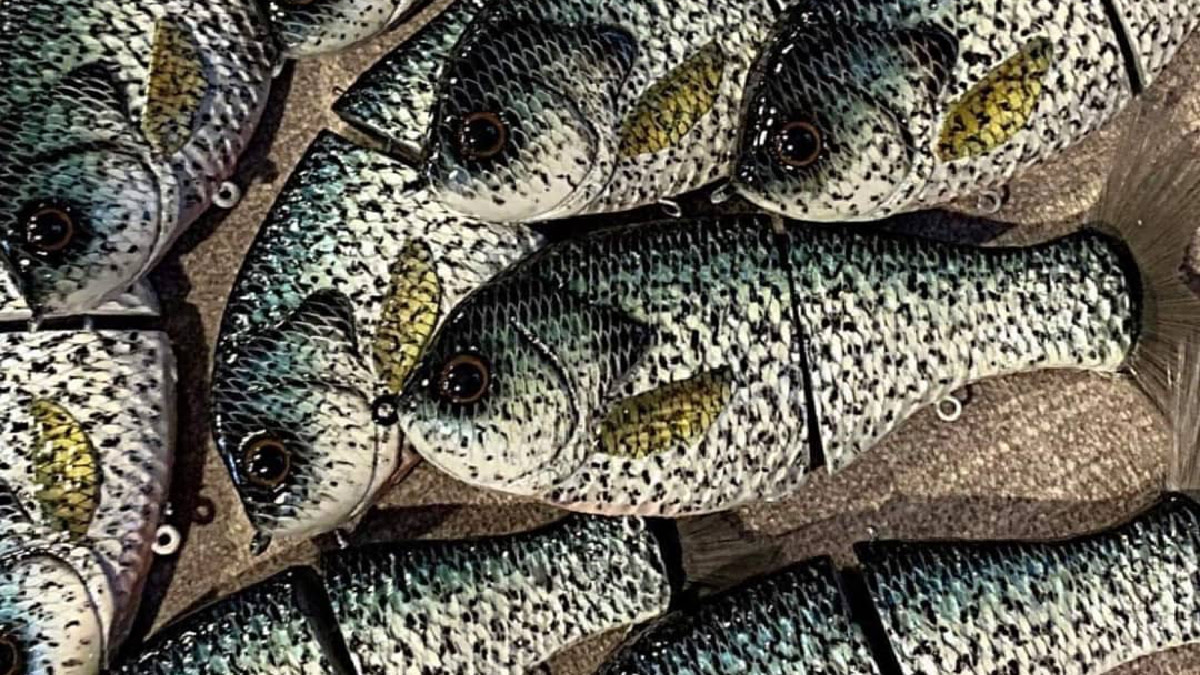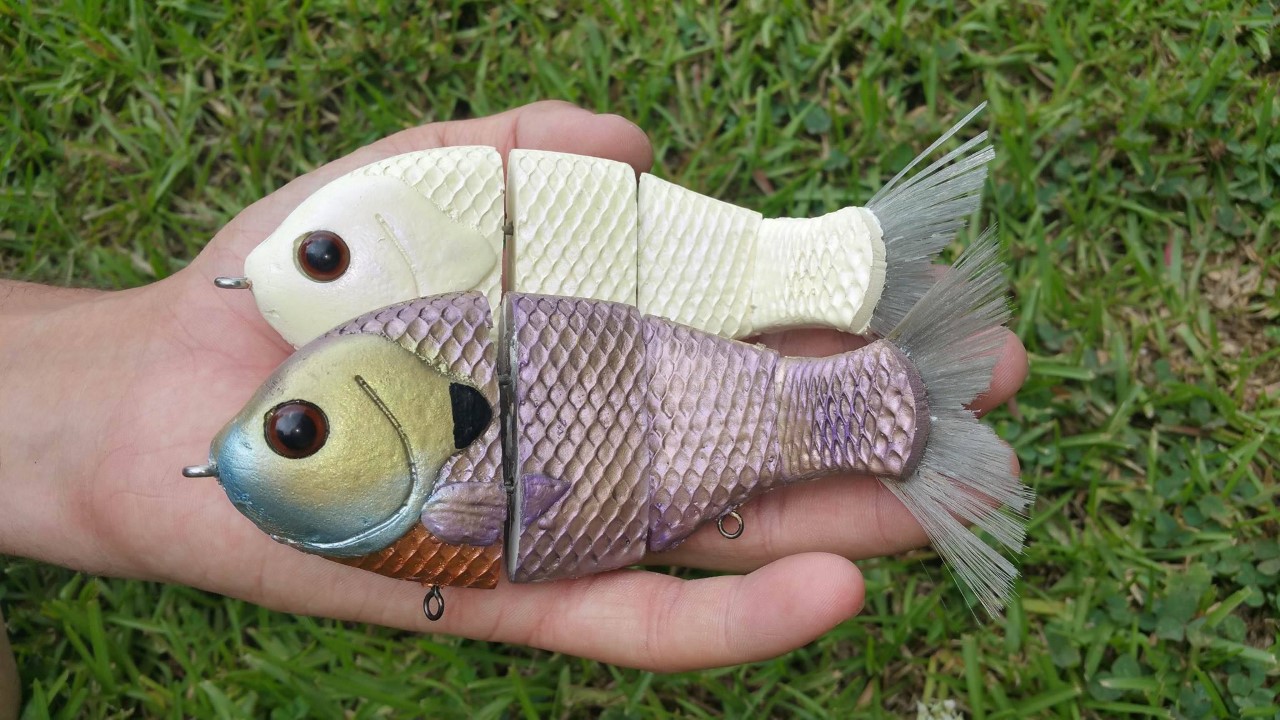
Walking down the dock on Day One of the 2014 Bassmaster Classic at Alabama’s Lake Guntersville, dodging fanboys, photographers, and jersey-laden anglers who looked like NASCAR drivers, I stopped at each boat. I didn’t need to talk to anyone, I just wanted to know what the fish were biting.
Sure enough, the championship qualifiers had many rods on the decks of their glitter boats, most adorned with mass-produced baits, generally from their sponsors. Time and time again, however, I noticed an oversized, multi-segmented bait—dull gray or bone, with a broom tail. It was Mike Bucca’s Bull Shad, a true small-scale garage bait. The prior day I’d been in one of Birmingham’s largest outdoor retailers and had noticed that the few Bull Shad pegs were empty.
At the time, Bucca, a lumbering child of the deep South, was transitioning from 24 years in the restaurant business to a full-time career as a baitmaker. Less than a decade later he is a rock star—at least to the people who care about enormous handmade lures and the universe that revolves around them. That rapidly growing group responds similarly to the names of OGs like Matt Servant, Mike Shaw, Jerry Rago, Mickey Ellis, Allan Cole, and Ken Huddleston. Maybe they’re not widely known, even in the fishing community, but among those in the swimbait fraternity they connote quality, history, and community.
A Club Without Boundaries What’s so odd to me about these swimbait gurus and fanatics, as an interested outsider looking in, is the notion of culture. While there are plenty of traditional good ol' boys who fit the original bassing mold, the swimbait crew also encompasses and reflects bits of other semi-marginalized groups and interests: heavy metal, punk rock, hip-hop, skateboarding, comic book collecting, surfing, sneakerheads, and so on. Just when you think you’ve narrowed down the mold, you see someone who looks like your accountant posting on Facebook that they just scored a coveted Pizz dispenser in a rare pattern.
“We’re a merry band of misfits,” said Pennsylvania angler Wayne Campbell, one of the moderators of the popular Swimbait Universe Facebook group. “We’re a melting pot of people who all have the same drive and passion for big fish. We may have grown up watching Roland Martin and Bill Dance on TV, but this is its own thing.”
Whereas fishing is often a pastime of secrecy and exclusion–few serious anglers want to share their best spot, their secret lure, or a better-than-the-rest retrieve–swimbaiting is a culture of inclusion. Are there spats and rivalries? Of course. But it’s also a knowing glance to someone wearing a limited run T-shirt, or noticing the sticker on the back of a truck window.
“In a lot of types of fishing it’s everyone for themselves, but for us, the way to grow is to include more people,” said Chad Meenan, one of Campbell’s fellow Swimbait Universe moderators.
It's not entirely odd that Campbell is from Pennsylvania and Meenan hails from Massachusetts. For years, swimbait culture and production was centered in California, and gradually shot off to big bass locales like Texas, Alabama, and, of course, the big bass lakes of Mexico, but there’s no geographic limit. Campbell, who started off as a trout fisherman outside of the mold of the typical Orvis-clad cognoscenti, found that his local Pennsylvania trout-stocked lakes were prime for some California-style big baits that look, you guessed it, like stocked trout. From March to May, he never goes anywhere without his 8-inch “Hudd” (Huddleston) trout bait at the ready.
Campbell admits that most of the time a Senko will outfish the big swimbaits, “but that’s not the thought process behind it,” he said. “The big draw to the culture is that mentality to keep grinding. You might go trip after trip without a sniff, but the next trip after that could be the fish of a lifetime, the baddest fish in the lake. I don’t mind if I don’t catch those 2- and 3-pound fish. It’s a sacrifice I’m willing to make.”
And there are many anglers like him–all across the country and all across the globe.
Picking Up the Jargon So, backing up for a second, I’m just now getting to where I should have started by answering the question, “What the hell is a swimbait?”

The answer, just like the answer to, “What does a swimbaiter look like or wear?” is again completely in the eye of the beholder. There are 3-inch long soft plastic “swimbaits” that cost a buck apiece and 24-inch trout replicas that would look good over a fireplace. There are lures that imitate shad, trout, bluegill, rats, muskrats, possums, and everything in between. There are crankdowns, gliders, and wake baits. Even within categories there are sub-categories–cover glides and open water glides, for example.
Generally, for purposes of the “cultural” aspect, the definition comes down to those who appreciate not only big baits, but also customized pieces of art that not everyone can enjoy. There’s sticker shock for those who aren’t used to the price points. I remember how a $9 Terminator spinnerbait, a $5 tungsten weight, or a $15 Lucky Craft Pointer inspired a mix of awe and disdain when they first came out. Now multiply that substantially. True believers are on wait lists and message boards looking for a chance to spend $200 to $400 on a custom-painted, limited edition lure. Even the average weekender or tournament angler has lifted any prior spending caps.
You can even buy a leather-wrapped 43-ounce lure for $1,147 direct from a major retailer, while supplies last!
“There are plenty of guys who get in on what we consider ‘entry-level’ baits,” Meenan said. “They may cost $10 to $50 and they’re readily available. Then they start catching better fish and end up buying everything in sight. Eventually they circle back and try to reduce it down to the things that work for them. It’s a mistake a lot of anglers make. They jump in with both feet without doing a ton of research first. It’s like learning in reverse.”
The pain of losing a lure that costs $75 or more is substantial, but perhaps not any greater than seeing a fish that you never knew existed chomp down on that bait and then get off.
Of course, the rarity and desirability of these lures results in all sorts of shenanigans to obtain them. There are message boards and auction sites where you can pay a premium, or you can try to get in on a manufacturers’ “drop.” They’ll announce on social media that their website will be stocked up at a given time, and then it’s first-come-first-served, often with limits on the number you can buy.
“What it boils down to is that there are more people that want your baits than you can actually supply,” Bucca said. “Be mindful that custom swimbaits are 100% built from scratch. No overseas stuff, no machines that allow you to do serious volume, so there’s really no fair way to distribute or sell the baits aside from drops.”
In other words, it pays to be a tech guru or have fast fingers if you want to get the good stuff.
The drops lead to one other issue: “flippers,” a term that took hold in fast-paced housing markets and now extends to just about any other desirable but limited commodity. There are some anglers (or even non-anglers) who take advantage of the drops to obtain baits and then flip them for profit. Meenan believes that there’s more of an overlap between anglers and flippers than you might assume. “They’re taking a leap on a drop and otherwise plenty of baits end up sitting on a shelf,” he said.
The Gathering Obviously, social media has lubricated the ability for like-minded people worldwide–swimbaiters or otherwise—to get together, but even in a virtual era where a pandemic has further isolated us, the Swimbait Universe crew saw the value of getting together. Noting that there had been other affiliate group meetings out West, they decided to hold their “Gathering” on the banks of Virginia’s Chickahominy River. It combines a retail show, a fishing tournament, and a considerable amount of beer drinking. The result has been, as best I can tell, a combination of Woodstock, Comic-Con, and the Bassmaster Classic.
The Gathering started in 2019 with 10 vendors and has grown consistently since. Last year, “with terrible weather, we had 25 vendors and over 500 people,” Campbell said. “A guy drove down from Maine with his 70-year-old dad and said it was the best weekend he’d ever had. Guys lined up at 2 a.m. for the gates to open up at 11.”
While baits in dropworld may not always be easy to obtain because it’s a low-volume, labor-intensive, highly-personal endeavor, that’s what makes the Gathering so important.
“The newer generation of builders want to engage more,” Meenan said. “Some of the older guys like Matt Servant were always easy to talk to. Cesar from Toxic came and he was really cool. This is a chance to meet them and talk to them and see a lot of swimbaits that you might never see in your hometown tackle shops.”
It creates a level of intimacy and bonding that the internet typically obscures, and indeed Meenan said he’s most proud of the “giving aspect” of the group. “It’s about some guy you never met on the other side of the country calling you to give advice on how to fish a particular bait. Or the fact that in 10 minutes we can raise 20 grand for a member whose house burned down. Sometimes these things get overlooked in the drama.”

“We do a whole lot of charity stuff,” Bucca agreed. “For example, the Swimbait Culture autism event where all the builders donate an autism-themed bait for raffle to raise money for autism.”
Bucca Circles Back So what’s the end game, or is there an end game, for swimbaiting culture?
The hard-core big baiters seem to embrace it when a mainstream pro like Brandon Palaniuk, Carl Jocumsen, or Steve Kennedy shows off their swimbait prowess in a televised tournament. It provides legitimacy and a further sense of belonging. Yet I can’t help but wonder: In a hobby-slash-lifestyle where rarity is prized just as much as inclusion, does the increasing popularity reduce the cache? Is it a Yogi Berra aphorism come to life? “Nobody goes there anymore. It’s too popular.”
Bucca is the perfect man to ask about this. A decade ago he was trying to scratch out a place in the fishing industry, now he’s an institution of sorts, on speed dial with the pros. He’s also a bridge between niche baits and the mass-produced stuff.
“Bull Shad is really still a ‘garage’ company,” he said. “We are just more efficient and have employees where other companies are one-man shows. We still make the baits 100% from scratch, just in a product line style. We are unique in the fact that we still offer over 40 different SKUs at a sub $70 price point. Seems like the starting price for most baits are $100-plus. I think that’s important for growth. Most people don’t go from a $14.99 jerkbait to a $120 swimbait. There are usually baby steps in between to get there and that is where we play a major role. I feel like we bridge the gap from the entry level to the custom market due to our pricing and availability.”
Bucca has partnered with Catch Company to produce an “entry level” bait and offers “HD” models for the true enthusiast–something for everyone. He doesn’t resent the fact that more large-scale manufacturers are getting into the game, or that swimbaits and swimbait culture are becoming more widely known. That’s a boon for business and a validation of what he’s known all along.
“I feel that swimbaits as a whole are still in their infancy,” he said. “There’s lots of growth left.”





Conversation